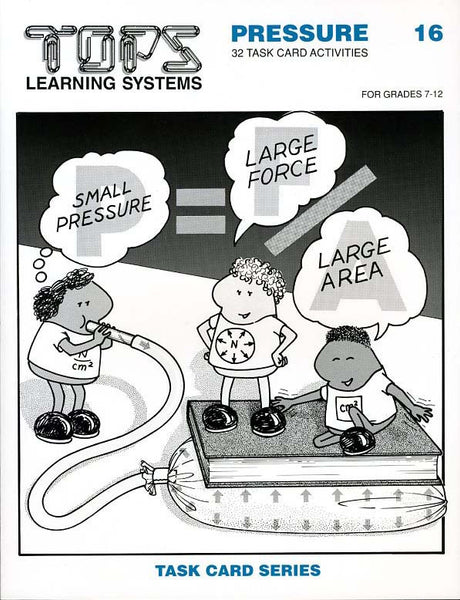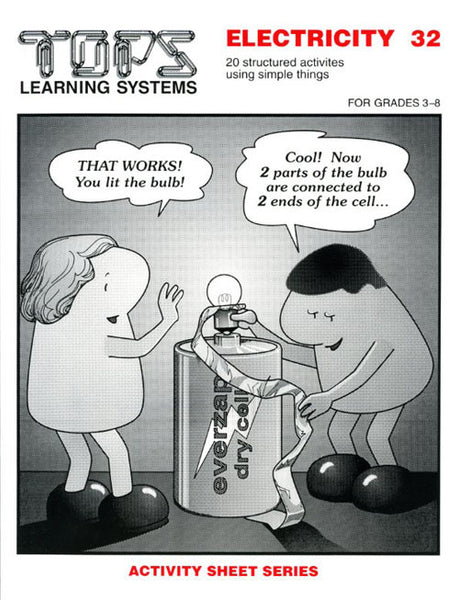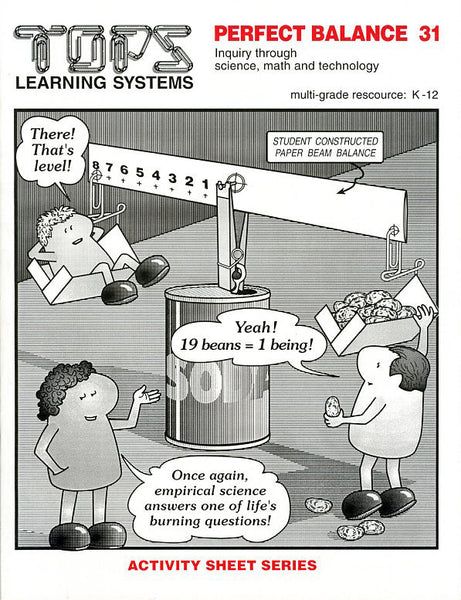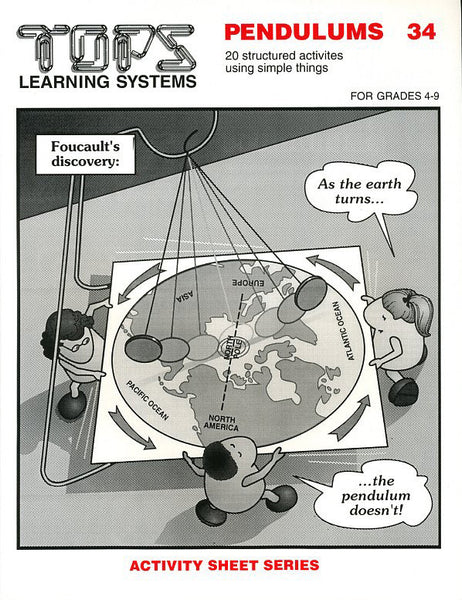#16 Pressure (grades 7-12)
Regular price $22.95
Soft-bound, 80 page book, 32 reproducible task cards, full teaching notes.
Teaching about pressure is usually a matter of locating the right rubber stopper, with the correct number of holes, to fit a flask of the proper diameter, to accommodate glass tubing cut to the desired length. No wonder experiments on pressure usually end up as teacher demonstrations! We eliminate the hassle and safety hazards with rubber tubing, canning jars, rings and lids. Students construct airtight and watertight systems that measure pressure, expand balloons, siphon and pump water and more.
More Information – click any of the tabs below to learn more about this title
Click here for a complete list of materials and convenient shopping.
Key: (1st/2nd/3rd) denote needed quantities: (1st) enough for 1 student doing all activities; (2nd) enough for 30 students working in self-paced pairs; (3rd) enough for 30 students working in pairs on the same lesson. Starred* items may be purchased below.
* 0.1/1/1: cup oil-based modeling clay1/10/10: index cards
1/10/10: pair of scissors
1/2/4: bathroom scales (optional)
1/10/10: calculators
* 1/5/5: rolls masking tape
* 5/50/50: straight plastic straws
* 2/20/20: meters 1/4 inch diameter tubing
3/30/30: plastic sandwich bags
4/40/40: meters string
3/9/30: textbooks
2/20/20: plastic produce bags
* 1/10/10: paper clips
3/30/30: standard-sized canning jars
* 3/30/30: standard-sized canning rings and lids
* 1/6/10: small plastic syringes (perhaps 3 cc)
* 1/4/10: large plastic syringes (perhaps 30 cc)
* 1/10/10: small test tubes
* 1/10/10: large test tubes
1/10/10: large plastic dishpan or equivalent to catch water
1/1/1: water source
* 1/10/10: baby food jars (or beakers)
* 1/10/10: clear soft-plastic drinking cups
* 1/6/10: large nails, about 3 1/2 inches
1/6/10: needle-nose pliers
* 6/60/60: washers with 5/16 inch diameter holes
* 1/10/10: small balloons
* 3/30/30: large rubber bands
* 2/20/20: eyedroppers
2/20/20: wooden matches
1/10/10: cereal boxes
2/20/20: cups sand (or gravel, or dirt)
* 1/1/1: bottle food coloring
1/1/1: jar petroleum jelly
* 1/10/10: clothespins
1/4/10: pie tins
1/6/10: medium-sized tin cans
1/4/10: funnels
2/20/20: paper towels
*1/6/10: Ping-Pong balls
1/6/10: cardboard toilet tissue tubes
1/2/5: hole punch tools
* 1/6/10: candles and matches
* 1/10/10: 100 mL graduated cylinders
1/4/10: large plastic milk jugs
* 2/20/20: BB shot pellets
2/20/20: size-D batteries, dead or alive
1/1/1: large capacity (1000 gram) balance
1/4/10: long clipboards (or plywood squares, or thick telephone books)
1/1/1: bottle rubbing alcohol
* 1/4/10: film canisters (or pill vials)
1/1/1: roll plastic wrap
1/4/10: flat toothpicks (optional)
1/10/10: large cider jugs (optional)
- Lesson 1: To calculate pressures that squeeze clay when you stand on it. To observe how these pressures increase as your applied force is distributed over decreasing areas.
- Lesson 2: To estimate pressures, in Newtons/cm^2, that one exerts while standing on the floor. To compare these pressures with the earth's atmospheric pressure.
- Lesson 3: To feel a direct transfer of pressure between squeezing a bag and inflating your lungs. To understand that fluids transfer pressure changes to all points in a closed system; that these changes act in all directions.
- Lesson 4: To experience how force increases as pressure is applied over larger areas. To observe how fluid systems give a force advantage at the expense of distance.
- Lesson 5: To calculate the force of the atmosphere pushing against known areas. To feel the effect of this force when the equalizing pressure is partially reduced on the opposite side.
- Lesson 6: To experience the full force of earth's atmosphere pressing against a vacuum. To observe how this force increases with increasing area.
- Lesson 7: To observe how atmospheric pressure acts in all directions, holding water inside a test tube. To use atmospheric pressure to transfer water with a straw.
- Lesson 8: To observe how water moves downward in response to gravity or upward in response to pressure. To construct a 1-hole cup for use in later activities.
- Lesson 9: To understand how the diaphragm regulates air pressure in the chest cavity, causing the lungs to expand and contract.
- Lesson 10: To support a column of water with atmospheric pressure, then siphon it down with gravity.
- Lesson 11: To apply Pascal's principle to a closed system, observing the effects of pressure changes in an eyedropper half full of water. To construct a 1-hole sealing lid for use in later activities.
- Lesson 12: To explain the sinking and floating action of an eyedropper as water is forced in and out of the dropper by changes in water pressure.
- Lesson 13: To construct a U-tube manometer. To understand that it measures differences in pressure, not total pressure.
- Lesson 14: To relate readings on the U-tube manometer to total pressure. To investigate the relationship between pressure and fluid depth.
- Lesson 15: To discover that atmospheric pressure supports the same difference in water levels in both straight tubes and U-tubes. To observe that height, not volume, is the variable that matters.
- Lesson 16: To observe how water flows in response to changes in pressure or gravity. To understand that water seeks its own common level, unless supported by a difference in pressure.
- Lesson 17: To reinforce the idea that water height, not volume, determines pressure.
- Lesson 18: To analyze a fluid system that is driven by continuous changes in pressure.
- Lesson 19: To apply Bernoulli's principle of low-pressure fluid streams to simple demonstrations involving a Ping-Pong ball.
- Lesson 20: To measure the low pressure effects of moving air with a manometer, relating the speed of the air stream to the magnitude of the pressure changes. To construct an atomizer.
- Lesson 21: To construct an airfoil and observe how it flies. To account for its lift by applying Bernoulli's principle.
- Lesson 22: To account for the curved flight of spinning Ping-Pong ball using Bernoulli's principle.
- Lesson 23: To fill a test tube with steam. To observe how the atmosphere pushes water inside to fill the vacuum created as the steam condenses.
- Lesson 24: To create a near vacuum in a test tube. To break its clay seal under water and watch the atmosphere push water into the void.
- Lesson 25: To calculate the maximum length that a test tube could reach and still have all its water supported by atmospheric pressure.
- Lesson 26: To experimentally calculate atmospheric pressure in Newtons/cm^2.
- Lesson 27: To design and build a vacuum pump. To understand how one-way valves and atmospheric pressure act to lift water.
- Lesson 28: To fill a jar with just enough water to simulate a pressure of 1/10 atmosphere. To develop a standard of comparison to use in the next activity.
- Lesson 29: To estimate the maximum air pressure that once can exert with the lungs.
- Lesson 30: To calculate the maximum load you can lift by blowing air into a produce bag. To use body weight to confirm that your calculated force has the correct order of magnitude.
- Lesson 31: To observe how changes in temperature and volume affect pressure. To develop equations that relate these variables.
- Lesson 32: To model how an aneroid barometer works. To build an instrument that measures atmospheric pressure.
We encourage improvisation - it's one of the main goals of our hands-on approach! You and your students might invent a simpler, sturdier or more accurate system; might ask a better question; might design a better extension. Hooray for ingenuity! When this occurs, we'd love to hear about it and share it with other educators.
National Science Education Standards (NRC 1996)
Teachers of science...
A: ...plan an inquiry-based science program. (p. 30)
B: ...guide and facilitate learning. (p. 32)
C: ...engage in ongoing assessment of their teaching and of student learning. (p. 37)
D: ...design and manage learning environments that provide students with the time, space, and resources needed for learning science. (p. 43)
• Represent a central event or phenomenon in the natural world.
• Represent a central scientific idea and organizing principle.
• Have rich explanatory power.
• Guide fruitful investigations.
• Apply to situations and contexts common to everyday experiences.
• Can be linked to meaningful learning experiences.
• Are developmentally appropriate for students at the grade level specified.
Core Concepts/Processes: Pressure is a force distributed uniformly over an Area (P = F/A). • We live under a vast ocean of air that exerts pressure in all directions. • Pressure in open and closed systems.
Core Inquiries: Observe, measure and predict changes in pressure in centimeters of water and pounds per square inch.
Core Content: Mechanical pressure • Air pressure • Water pressure • Atmospheric pressure • Fluids • Siphons • Pumps • Barometers • Ideal gas relationships
TEACHING Standards
These 32 Task Cards promote excellence in science teaching by these NSES criteria:Teachers of science...
A: ...plan an inquiry-based science program. (p. 30)
B: ...guide and facilitate learning. (p. 32)
C: ...engage in ongoing assessment of their teaching and of student learning. (p. 37)
D: ...design and manage learning environments that provide students with the time, space, and resources needed for learning science. (p. 43)
CONTENT Standards
These 32 Task Cards contain fundamental content as defined by these NSES guidelines (p. 109).• Represent a central event or phenomenon in the natural world.
• Represent a central scientific idea and organizing principle.
• Have rich explanatory power.
• Guide fruitful investigations.
• Apply to situations and contexts common to everyday experiences.
• Can be linked to meaningful learning experiences.
• Are developmentally appropriate for students at the grade level specified.
Unifying Concepts and Processes
NSES Framework: Systems, order, and organization • Evidence, models and explanation • Constancy, change, and measurement • Evolution and equilibrium • Form and functionCore Concepts/Processes: Pressure is a force distributed uniformly over an Area (P = F/A). • We live under a vast ocean of air that exerts pressure in all directions. • Pressure in open and closed systems.
Science as Inquiry (content standard A)
NSES Framework: Identify questions that can be answered through scientific investigations. • Design and conduct a scientific investigation. • Use appropriate tools and techniques to gather, analyze, and interpret data. • Develop descriptions, explanations, predictions, and models using evidence. • Think critically and logically to make the relationships between evidence and explanations. • Recognize and analyze alternative explanations and predictions. • Communicate scientific procedures and explanations. • Use mathematics in all aspects of scientific inquiry.Core Inquiries: Observe, measure and predict changes in pressure in centimeters of water and pounds per square inch.
Physical Science (content standard B)
NSES Framework:Motions and forces • Structure and properties of matterCore Content: Mechanical pressure • Air pressure • Water pressure • Atmospheric pressure • Fluids • Siphons • Pumps • Barometers • Ideal gas relationships






